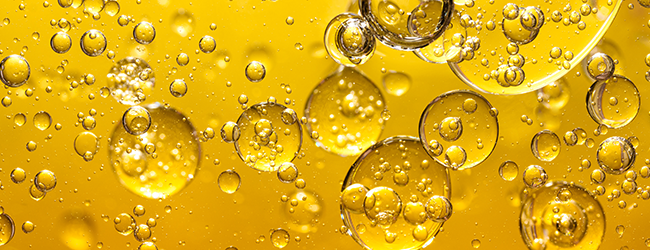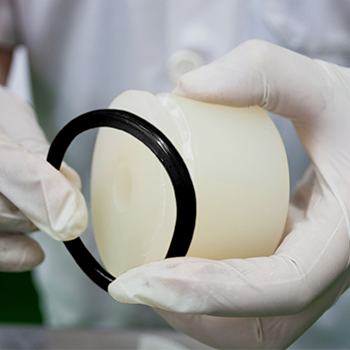Base Oils
Most greases consist of three parts: a base oil, additives, and thickeners. When selecting a base oil for your application, it should be compatible with your temperature, material, load, and any other operating requirements. With so many variations in plastics and elastomers, a product should always be tested for material compatibility.

Our base oil compatibility matrix can be a useful tool in understanding which lubricants are compatible with your application. Common characteristics include viscosity index, pour point, material Compatibility, chemical resistance, oxidative stability, wear resistance, and outgassing performance.
- Perfluoropolyethers (PFPE)
- Multiply-alkylated Cyclopentane (MAC)
- Polyalphaolefins (PAO)
- Polyglycols
- Polyphenylethers (PPE)
- Silicones
- Synthetic Esters
- Alkylated Naphthalenes (AN)
![]()
Perfluoropolyethers (PFPE)
Temperature Range: -90 to 250°C
PFPEs are extremely stable, nonflammable, chemically inert, low vapor pressure fluids with exceptional resistance to water and oxidation. Because they are inert, PFPEs are resistant to chemical attack by most chemicals such as sulfuric acid, sodium hydroxide, etc. This also means they’re not soluble in most common solvents with the exception of fluorinated solvents. This base oil is typically used in extreme environments and to avoid plastic and elastomer compatibility problems.
PFPEs have poor heavy-load performance and poor additive solubility. Certain alloys containing titanium and aluminum can cause a catalytic depolymerization of PFPE fluids at high temperatures. This effect is commonly referred to as the “Brown Sugar Effect” due to its appearance. PFPE base oils are also two times more dense than synthetic hydrocarbons because the molecular weight of fluorine is much higher than that of hydrogen.
![]()
Multiply-alkylated Cyclopentane (MAC)
Temperature Range: -45 to 125°C
MACs are a highly specialized fluid that combines the low vapor pressure of a PFPE with the lubricity and film strength of a PAO. This base oil is typically used in aerospace and critical vacuum applications.
MAC polymers have a molecular structure that resists wear-related breakdown making them ideal for heavily loaded, metal-on-metal applications. MACs also have a high surface tension, which means they have good film strength that will ensure moving parts are coated to minimize contact and friction.
MAC fluids are compatible with a wide range of materials so that they can also be used where plastic parts may encounter the lubricant. These fluids can be formulated with a wide variety of additives including anti-wear agents, extreme pressure agents, and antioxidants to achieve the desired performance of the lubricant.
While MAC products offer a host of benefits not found anywhere else, they do pose certain limitations. For example, MAC products have a limited temperature operating range of -50 °C to 125 °C. If an application, like those found in space, requires the low outgassing and excellent wear performance of a MAC lubricant and the operating temperature is below -50 °C, engineers may consider adding a heater to their design that raises the temperature into the operating temperature range of MACs.
![]()
Polyalphaolefins (PAO)
Temperature Range: -60 to 125°C
PAOs are stable, lubricious fluids that are compatible with most plastics and elastomers. This base oil offers a low pour point, high viscosity index (stable viscosity over temperature), good thermal stability, and excellent wear reduction. This base oil can be used as a drop-in replacement for petroleum and is used in countless applications in many industries. PAOs are relatively inexpensive base oils. Like MAC fluids, PAOs can be formulated with a wide variety of additives to achieve the desired performance.
![]()
Polyglycols
Temperature Range: -40 to 125°C
Polyglycols offer good load-carrying ability, have a high viscosity index, and are compatible with most elastomers. Polyglycols are often used in arcing switches because they are non-carbonizing, clean lubricants. These base oils offer good low temperature fluidity with pour points in the range of -20 to -50ºC. Polyglycols have compatibility issues with some plastics and elastomers and offer poor volatility over 100°C,
![]()
Polyphenylethers (PPE)
Temperature Range: 10 to 250°C
Polyphenyl ethers (PPEs) are radiation, chemical, and acid-resistant fluids that are traditionally used for noble-metal connectors and high-temperature mechanical components. They have a high surface tension, meaning they do not wet metal surfaces. PPEs are often recommended for use in ultrahigh vacuum diffusion pumps and nuclear power plant components.
![]()
Silicones
Temperature Range: -70 to 200°C
Silicones have low surface tension, meaning they have good wetting characteristics. These fluids are chemically inert and are compatible with many materials including plastics and elastomers. Silicones also have a high viscosity index, high thermal stability, and low pour points, making them suitable for a wide temperature range. These base oils are not compatible with other silicone materials and offer poor film strength. Common applications for silicones include plastic gears, control cables, and seals.
![]()
Synthetic Esters
Temperature Range: -65 to 150°C
Synthetic esters are stable, resist wear, and offer excellent oxidative and thermal stability. This base oil has an affinity for metals, handles heavy loads well, and is great for loaded bearings. Synthetic esters are typically not recommended for plastics and elastomers as they exhibit compatibility issues, however, synthetic esters can be used at lower treat levels to provide intentional swelling of elastomers.
![]()
Alkylated Naphthalenes (AN)
Temperature Range: -30 to 180°C
Compared to PAOs and diesters, AN’s offer improved hydrolytic, thermal, and oxidative stability but ANs have inferior or less desirable pour points. This base oil is a good blendstock for polyalphaolefins requiring high stability under extreme conditions. At higher temperatures, AN’s have been known to exhibit elastomer compatibility issues.


